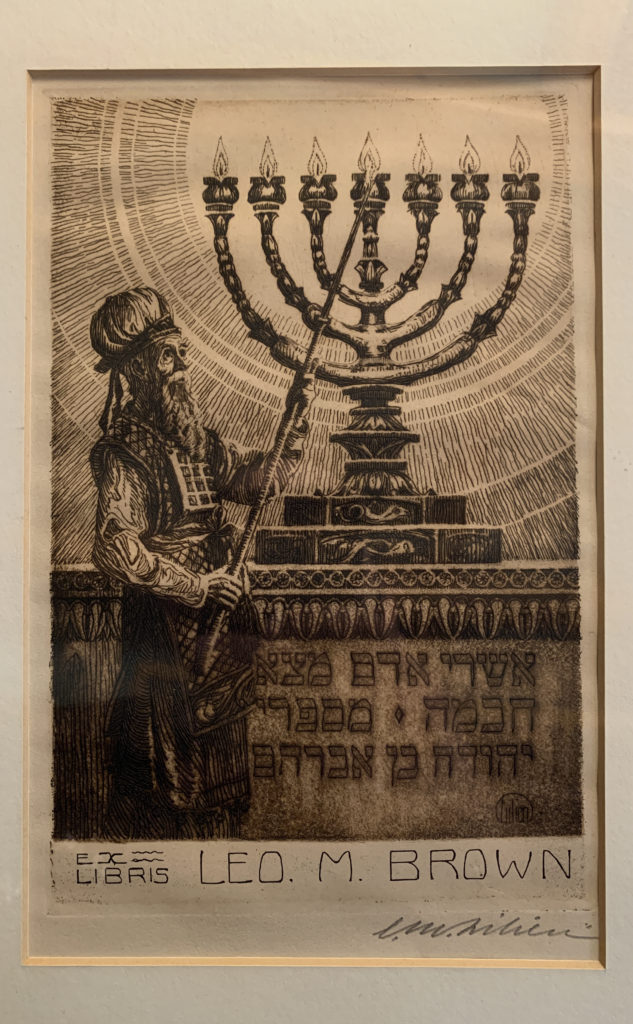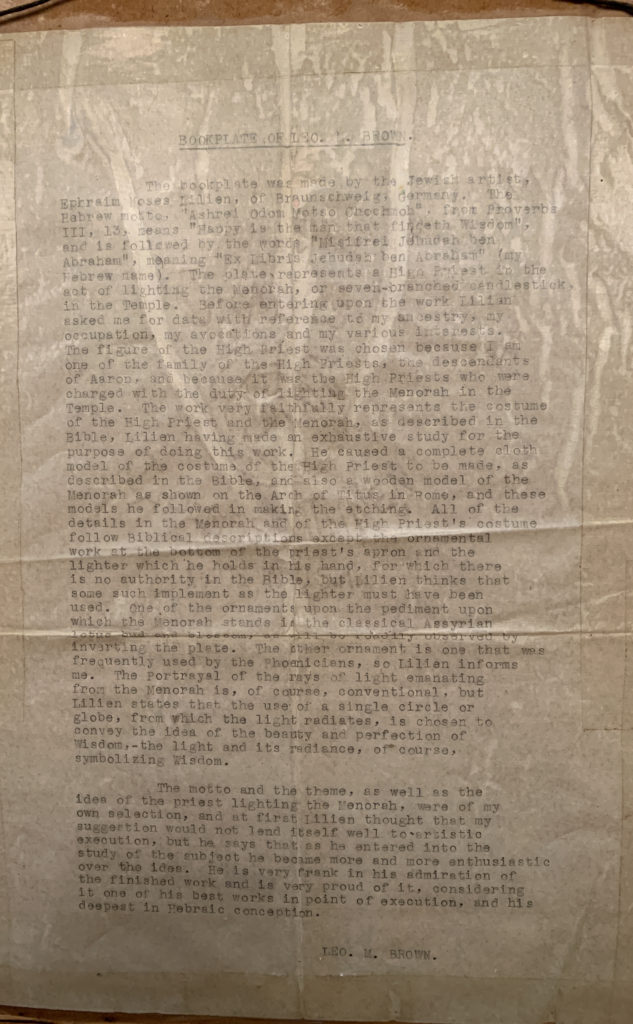This past year I’ve been splitting time between my home in Eugene, Oregon and my Mom’s house in El Sobrante, California.
Getting to spend time with my Mom (Bergie) and my Stepdad (Steve) has been great and it’s also allowed me to appreciate some of the wonderful trappings that come with 80+ years of two well-lived lives.
Many of the items in and around the house are familiar to me, as they’ve been passed down from my Norwegian Maternal Grandparents….but every now and then, there is something new…or I see something with a fresh appreciation. Since there are so many interesting things, I thought I’d share a few.
BOOKPLATE FOR LEO. M. BROWN.
Yesterday my Mom showed me a picture frame I had seen before but not really considered. It was an etching portraying a man lighting a Menorah. My Mom explained it had been given to my Grandmother, Tordis Bornholdt by a friend, Mr. Brown. The back had a yellowing piece of paper explaining the history of the piece.


BOOKPLATE OF LEO. M. BROWN.
The bookplate was made by the Jewish artist, Ephraim Moses Lillien, of Braunschweig, Germany. The Hebrew Motto, “Ashrei Odom Motso Chochmoh”, from Proverbs III, 13, means “Happy is the man that findeth Wisdom”, and is followed by the words “Misifrei Jehudah, ben Abraham” meaning “Ex Libris Jehudah ben Abraham” (My Hebrew name). The plate represents a High Priest in the act of lighting the Menorah, or seven-branched candlestick, in the Temple. Before entering upon the work, Lillien asked me for data with reference to my ancestry, my occupation, my avocations and my various interests. The figure of the High Priest was chosen because I am one of the family of the High Priests, the descendants of Aaron, and because it was the High Priests who were charged with the duty of lighting the Menorah in the Temple.
The work very faithfully represents the costume of the High Priest and the Menorah, as described in the Bible, Lillien having made an exhaustive study for the purpose of doing this work. He caused a complete cloth model of the costume of the High Priest to be made, as described in the Bible, and also a wooden model of the Menorah as shown on the Arch of Titus in Rome, and these models he followed in making the etching. All of the details in the Menorah and of the High Priest’s costume follow Biblical descriptions except the ornamental work at the bottom of the Priest’s apron and the light which he holds in his hand, for which there is no authority in the Bible, but Lillien thinks that some such implement as the lighter must have been used. One of the ornaments upon the pediment upon which the Menorah stands is the classical Assyrian lotus bud and blossom, as will be readily observed by inverting the plate. The other ornament is one that was frequently used by the Phoenicians, so Lillien informs me. The Portrayal Of the rays of light emanating from the Menorah is, of course, conventional but Lillien states that the use of a single circle or globe, from which the light radiates, is chosen to convey the idea of the beauty and perfection of Wisdom, the light and its radiance, of course, symbolizing Wisdom.
The motto and theme, as well as the idea of the Priest lighting the Menorah, we of my own selection, and at first Lillien thought that my suggestion would not lend itself well to artistic execution, but he says that as he entered into the study of the subject he became more and more enthusiastic over the idea. He is very frank in his admiration of the finished work and is very proud of it, considering it one of his best works in point of execution, and his deepest in Hebraic conception.
LEO. M. BROWN
I found this piece interesting on many levels. The first was the consideration that went into the creation of a label for Mr. Brown’s books. This was from a time (perhaps 90 years ago) when books had a much higher value than I think we put on them today.
Next was the level of inclusion of the religion and history within the concept. Mr Brown’s religion was so clearly ingrained in who he was and of course that would be reflected in the marker for all of the books in his library. Nowadays, I fear so many demonstrations of religious faith seem to contradict the actual religion they are meant to represent, that this artistic representation of a religious scene meant “to convey the idea of the beauty and perfection of Wisdom” is very compelling and refreshing to me.
Finally was the craftsmanship that went into the creation of the bookplate. Not just a matter of creating a drawing to match the request from Mr. Brown, but the level of research and detail work hat went into the creation of the etching. Again, the word consideration comes to mind.
Given my focus of the last few years on learning a new craft (machining) and a growing consideration of the lack of craftsmanship in our increasingly buynowthrowawaytomorrow world, this piece really struck me.
Lots of things in the house to explore. I’ll find something else that catches my eye to post about next week.
-PEM
Wow, that bookplate was a serious piece of art! Thanks for sharing.
–intriguing stuff, patrice–your family is a treasure trove of fascinating people and their acquirements and acquisitions and experiences–xoxo, ednik–
My older books have bookplates. Seems my parents’ generation went in for them in a big way. I guess they assumed I’d order a set of my own when I felt the time was right. But they made a number of assumptions about what I would do that were ill-founded, as it happens.